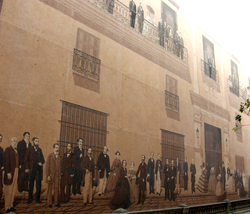People, Politics and Piña coladas
Not having had much background in Latin American history or culture, or even having visited our neighbors south of the border, I pretty much entered Cuba without any preconceptions about what we'd experience. We live in a global society, and one of the main reasons I travel is to try to increase understanding, including my own, through direct exploration and interaction. After four trips to China, having made many friends there who were delighted by my interest in Asian stuff, I wasn't really worried about our reception as Americans; I've learned that personal connections can trump national politics if any effort is made to find common ground.
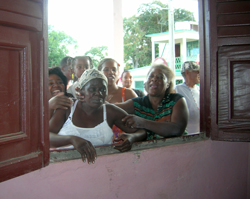 And so it was in Cuba. Since only feeble vestiges remaining of my high school Spanish prevented complex conversations, I wasn't able to ask or answer any probing questions (although I did share some of these, in translation, with Spanish-speaking members of our group), but everyone I met during the trip was pleasant and most were very friendly. We had a hilarious taxi trip in Cienfuegos with a driver who recognized us from the previous night's music event and wondered why were not out dancing, and met a charming young man poolside in Santa Clara who was having a weekend holiday with his family and introduced us all around.
And so it was in Cuba. Since only feeble vestiges remaining of my high school Spanish prevented complex conversations, I wasn't able to ask or answer any probing questions (although I did share some of these, in translation, with Spanish-speaking members of our group), but everyone I met during the trip was pleasant and most were very friendly. We had a hilarious taxi trip in Cienfuegos with a driver who recognized us from the previous night's music event and wondered why were not out dancing, and met a charming young man poolside in Santa Clara who was having a weekend holiday with his family and introduced us all around.
With Greg as our leader, we obviously met Cubans who did not travel in normal tourist circles, and their relationships with him extended to acceptance of all of us. Greg himself was very aware of the importance of Americans visiting Cuba with a respect for and appreciation of Cuban culture; after every presentation or performance we attended he thanked our hosts on our behalf, and when possible he included conversations with the musicians and artists so that they could tell us their stories. I hope we did him proud. I was also glad to be able to visit such sites as the Playa Giron museum and the Che Guevara Memorial, both of which were emotionally stirring.
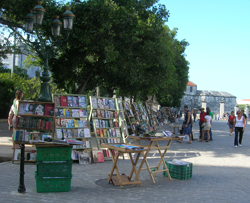 In our day to day activities with food, lodging, shopping, etc., we interacted with locals who were engaged in tourism and hospitality, and I have to compliment the hotel staff, waiters, bathroom lady monitors, souvenir hawkers and even street hustlers for being polite and not pushy (and a couple of them for having good taste in American baseball teams). It was a nice contrast to China, where we were constantly chanting "不要" ("no thanks") to old ladies following us around street markets with metal stacking turtles, or young shopgirls hovering in our faces while we tried to browse for CDs.
In our day to day activities with food, lodging, shopping, etc., we interacted with locals who were engaged in tourism and hospitality, and I have to compliment the hotel staff, waiters, bathroom lady monitors, souvenir hawkers and even street hustlers for being polite and not pushy (and a couple of them for having good taste in American baseball teams). It was a nice contrast to China, where we were constantly chanting "不要" ("no thanks") to old ladies following us around street markets with metal stacking turtles, or young shopgirls hovering in our faces while we tried to browse for CDs.
 Regarding politics… well, I avoid these discussions back home, even with friends (I'll block you on Facebook if you like to argue), so keeping the position of observer was no problem. Our lecturers and guides, obviously vetted by official governmental channels, demonstrated a national pride and a desire to participate in society and strive to improve conditions within the system. One impressive example was our tour of the Organopónica de Alamar, an innovative organic farm project just outside Havana, providing produce for city residents as well as explaining and promoting agriculture as a career to school children. Most Cubans we met were not wealthy, and many had had to survive hardships during the worst periods of the country's economic downturns (which are not yet over), but they were optimistic, good-natured, and generous with their time and patience. I'm sure there are political dissidents in Cuba; I did not meet any of them.
Regarding politics… well, I avoid these discussions back home, even with friends (I'll block you on Facebook if you like to argue), so keeping the position of observer was no problem. Our lecturers and guides, obviously vetted by official governmental channels, demonstrated a national pride and a desire to participate in society and strive to improve conditions within the system. One impressive example was our tour of the Organopónica de Alamar, an innovative organic farm project just outside Havana, providing produce for city residents as well as explaining and promoting agriculture as a career to school children. Most Cubans we met were not wealthy, and many had had to survive hardships during the worst periods of the country's economic downturns (which are not yet over), but they were optimistic, good-natured, and generous with their time and patience. I'm sure there are political dissidents in Cuba; I did not meet any of them.
Speaking of people, I have to say something about our local guide, Gustavo. A huge chunk of the success of a travel tour is having a good guide, and ours was great! I'm sure he had learned everyone's names way before we managed this ourselves, and his knowledge of Cuba (history, geography, economics, architecture, etc., etc.) was encyclopedic. After a few days we discovered more about his personal history: after a career as a fighter pilot in the Cuban air force, Gustavo lost his job in the economic crisis following the collapse of the Soviet Union and found a new career in tourism. With a base salary is $17CUC/month, he—as with every Cuban working in the service industry—relies on tips; these jobs actually pay more than most in the country. Greg and Gustavo had worked together on at least one previous trip, and Gustavo had also worked with Jorge, our bus driver (whom I suspect of having a more wicked sense of humor than we Anglos were able to appreciate).
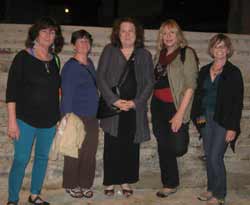 As for my "classmates", everyone was interesting and versatile, fun to get acquainted with, flexible with bumps in our schedule or plans, and generally a delight to travel with. Our group was nothing if not diverse. We had lots of educators, from CCSF and elsewhere, several people fluent in Spanish and already well-traveled in Latin America, and a group of younger students with energy enough (if a bit bleary in the morning) to go clubbing and dancing 'til the wee hours. It may have been the rum, but before we left the Havana airport we were already planning our first reunion.
As for my "classmates", everyone was interesting and versatile, fun to get acquainted with, flexible with bumps in our schedule or plans, and generally a delight to travel with. Our group was nothing if not diverse. We had lots of educators, from CCSF and elsewhere, several people fluent in Spanish and already well-traveled in Latin America, and a group of younger students with energy enough (if a bit bleary in the morning) to go clubbing and dancing 'til the wee hours. It may have been the rum, but before we left the Havana airport we were already planning our first reunion.
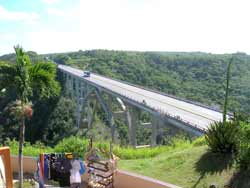 I do like a good mojito, and ever since Gong Li commandeered my cousin Colin's speedboat to take him to Havana for mojitos (in Miami Vice the movie), I've fantasized about drinking them in tropical Cuba. And they were good, very good; I did quite thorough research. My favorites (the strongest—and the cheapest at $2CUC) were the ones we had in Cienfuegos when we had our private Los Naranjos concert. That being said, one can also find very tasty piña coladas in Cuba, and they made a nice change of pace. When we left Havana for Matanzas and other points south, our first rest stop was at the overlook of the Bacunayagua Bridge spanning Rio Canimar. In addition to bathrooms and touristy souvenirs, they also sold piña coladas. The best ones I had during the trip, and with a difference: we were handed glasses with the milkshake-thick coconut/pineapple mix, and a bottle of rum to top it off as desired. Luckily it was before eleven am or this could have gotten very dangerous! Beer in Cuba is also decent, Cristal being the most popular and light enough for hot weather drinking. Bucanero was a second option, with heavier dark versions. And, as mentioned, our visit to the Plaza Vieja brewery gave us a taste of the local microbrew. I have to confess to being a bad tourist, as I did not follow Hemingway's footsteps to the Floridita for a daiquiri.
I do like a good mojito, and ever since Gong Li commandeered my cousin Colin's speedboat to take him to Havana for mojitos (in Miami Vice the movie), I've fantasized about drinking them in tropical Cuba. And they were good, very good; I did quite thorough research. My favorites (the strongest—and the cheapest at $2CUC) were the ones we had in Cienfuegos when we had our private Los Naranjos concert. That being said, one can also find very tasty piña coladas in Cuba, and they made a nice change of pace. When we left Havana for Matanzas and other points south, our first rest stop was at the overlook of the Bacunayagua Bridge spanning Rio Canimar. In addition to bathrooms and touristy souvenirs, they also sold piña coladas. The best ones I had during the trip, and with a difference: we were handed glasses with the milkshake-thick coconut/pineapple mix, and a bottle of rum to top it off as desired. Luckily it was before eleven am or this could have gotten very dangerous! Beer in Cuba is also decent, Cristal being the most popular and light enough for hot weather drinking. Bucanero was a second option, with heavier dark versions. And, as mentioned, our visit to the Plaza Vieja brewery gave us a taste of the local microbrew. I have to confess to being a bad tourist, as I did not follow Hemingway's footsteps to the Floridita for a daiquiri.
Return to Cuba 2012-2013 Index


